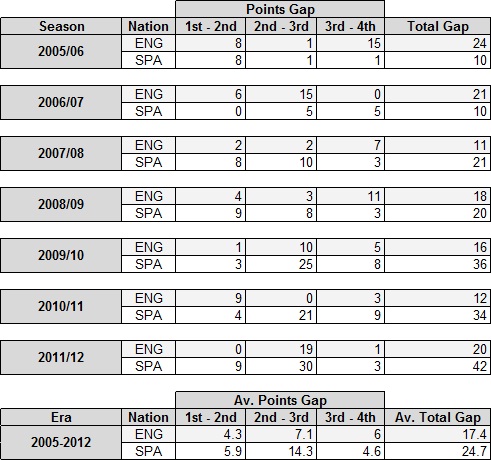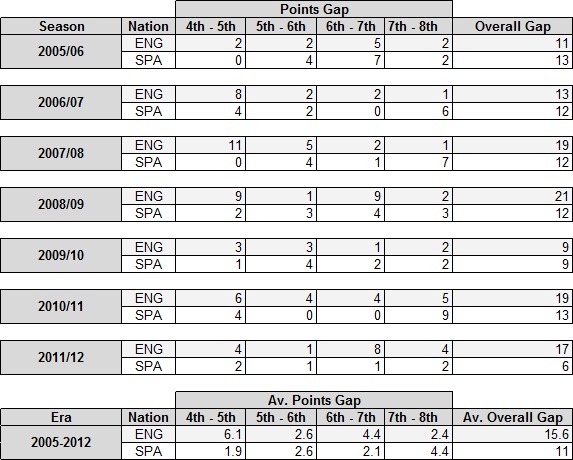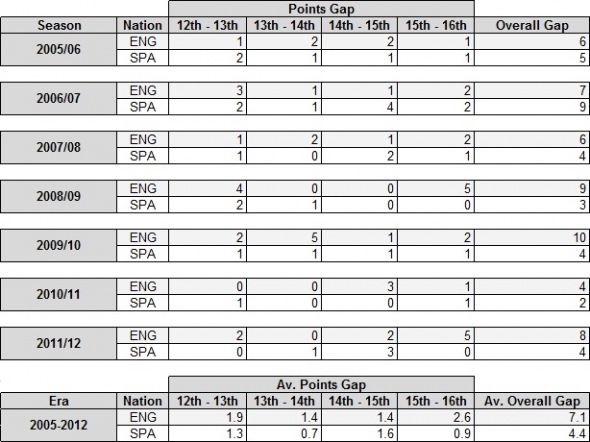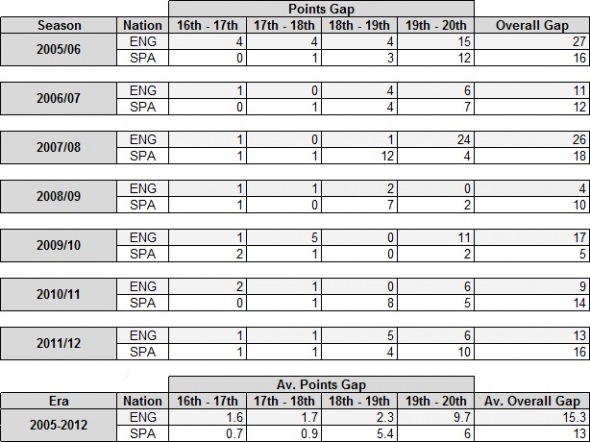The definitive Premier League vs La Liga debate… Part II
In Part I of this article I compared English football with Spanish by comparing how well teams did in European competition. Now it’s time to look deeper, using different criteria to judge the strength of the leagues.
Putting the Catalans to one side for the time being (finally), why is it that Chelsea – the European Champions – were beaten so heavily and so utterly convincingly, by a team from a league which is apparently of a lower all-round quality? Was it just a one-off game that shouldn’t be looked in to too much? Were they underwhelmed by the occasion and simply didn’t perform to the best of their abilities? Or is Champions League performance simply not enough to go on?
Atlético Madrid are the current champions of Europe’s second tier competition, the Europa League. In recent years, Spanish sides have seemingly dominated it with last seasons all-Spanish final, the second occurrence of such an event since 2005, the year which incidentally marked Sevilla’s immense back-to-back UEFA Cup victories. Since 2005, there have been four Spanish wins and six Spanish finalists. The two losing finalists as alluded to, lost to fellow Spaniards. If the Premier League is proven to be more superior when facing La Liga sides in the Champions League, why are Spanish sides playing in Europe’s second tier doing so well compared to the English? Could it be that the Premier League top-four tends to be superior to La Liga’s, but that the clubs below them are actually weaker than Spain’s? Does that even make any sense?
The problem with the UEFA Cup down the years and the Europa League as it has now become, is that English sides tend not to take it seriously, whereas their Spanish counterparts, simply put, do. The paragraph above makes it more than apparent. Long have I been adamant though, that had the likes of Tottenham Hotspur et al taken the competition seriously, the UEFA Cup could have adorned the trophy cabinet of many an English club in the last few years. Despite losing, Fulham proved that it’s more than achievable when they reached the Final in 2010 and Middlesbrough likewise in 2006. Obviously, they both lost to Spanish sides. With all due respect to the pair though, Fulham and Boro are no Tottenham. But alas, most English sides see it as a burden more than a privilege and so whilst Spain’s record in recent years is commendable, a similar breakdown to the one I did with the Champions League would be misleading.
It is because of this though, that the result between Chelsea and Atlético Madrid cannot simply be overlooked as an anomaly. If when the top teams from each league are compared, England come out on top by such a margin, the result does seem odd to say the least. Add into the equation Athletic Bilbao beating Manchester United last season, after the English side dropped into the Europa League, and it begs a question. Because English sides don’t take to the Europa League like the Spanish do, it means that we can’t really compare the ‘chasing packs’ of each league in a head to head manner. But if England’s elite (Chelsea and Manchester United in this instance), who are supposedly superior to Spain’s equivalents, are losing to teams adjudged to be below Champions League quality (Atlético Madrid and Athletic Bilbao), the results go some way to show that La Liga is perhaps more competitive than some would make out and that there is more beyond Barcelona and Real Madrid.
La Liga is notorious for being a two-horse race and at times, is even considered a non-contest. I’m guilty, like many other Englishmen, of branding it in such a way. Barcelona and Real Madrid are the only two sides considered at the start of the season and since 2005, only Villarreal – who were shockingly relegated last season – have broken the pairs stranglehold, when they finished second in 2008. But is the Premier League that much better? Since 2005, Manchester United and Chelsea have consistently been the top-two teams, with only Liverpool breaking the pattern when they finished second in 2009. That all changed last season however as Manchester City became the fifth team to win the Premier League title. With the money available to the team and the calibre of player already at the club and with Chelsea having purchased the likes of Eden Hazard in the summer, the Premier League looks set to become very much a three-horse race whereas in Spain, as much as it remains to be seen, it’s impossible to look past the two traditional powerhouses. But again, am I simply doing the league a disservice without really knowing any better? None of what I have written is backed up by anything credible as of yet. I’m simply regurgitating the common perception a lot of people have. Is there such thing as a three-horse race in Spain? Is the Premier League just a two-horse race itself? Is there any real competition lower down the league? A league needs to be competitive. As much as most top-flight leagues are always going to have a select few at the top and likewise at the bottom, if one team consistently runs away with it, the league risks becoming tedious. Let’s look at how ‘competitive’ each league really is.
Competitiveness within the Premier League and La Liga
The two leagues are both a big 20-team story in their own rights. Like any other good story though, football always throws up fascinating sub-plots and it is within these, that I believe the true competitive nature of round-robin football can be found. ‘The Race for 4th’ and ‘The Race for 40 Points’ can be equally as enthralling, but both have the potential to be just as equally predictable. Given that the two leagues are almost identical in format and structure – sharing similar European qualification standards and the same rules regarding relegation (albeit the Premier League uses goal-difference to separate sides on level points whereas La Liga uses the head-to-head results) – I have spilt the leagues into five sections of four to make it easier to compare. I have decided that the best measure of this is to look at how close teams finish to one another on points throughout the league. A smaller gap between teams, suggests a higher level of competitiveness. I guess the logical place to start is at the top.
‘The Top-Four’ (1st – 4th)
Having examined the final top-four from the two respective leagues since 2005, I have constructed the table below to show the points difference between each position. This includes the gaps between 1st through to 4th and an overall gap covering the section, as well as an average points difference over the last seven seasons.
As expected, the gap between 1st and 2nd is a lot smaller than the gap between 2nd and 3rd in both leagues. As a season goes on, more and more teams tend to fall away from the title-chase and there are often only two teams left who go into the final few games with a chance of winning the title. The average gap between 2nd and 3rd in Spain however is staggering. Whilst between 2005 and 2009, the two leagues were both relatively competitive in terms of the number of teams challenging for top-spot, since 2010 La Liga’s top-two have broken away to such an extent, that the average points difference between 2nd and 3rd is more than double the gap between the champions and the runners-up themselves. There is however a smaller gap between 3rd and 4th in Spain. But in terms of overall competitiveness at the summit, the Premier League wins hands down thanks also to a much smaller gap between the top and bottom of the section overall.
Verdict: Premier League 1 – 0 La Liga
‘The Chasing Pack’ (5th – 8th)
A lot is made about ‘breaking into the top-four’ in England, and one can only assume that there is a similar feeling in Spain. Spanish clubs’ affinity with the UEFA Cup though, makes finishing in these positions by no means a failure. The following table then looks at 5th through 8th using the same table format as above, as well as showing how far off the chasing pack were from breaking into the top-four.
Well, well, well. Now that is a turn up for the books. The competition for 4th place is much stronger on average in Spain than it is in England and it actually explains a lot. In the seven seasons, England has seen seven different sides finish in the top four whilst in Spain, there have been nine. The strong competition for Champions League football has clearly effected the Spanish sides dominance of the UEFA Cup and more importantly, explains why teams from the Spanish ‘chasing pack’ have recently overcome two of England’s traditional top-four. Quite simply, the competition has battle-hardened these sides and has given them a competitive edge. We’ve proved how ridiculously dominant the top-two is in Spain, so one can only assume that English sides have seen this and taken the rest of the league for granted. It’s hard to blame them really, as before doing this, I thought the same. It goes some way to prove that it isn’t the assumed poor standard of La Liga that enables Barcelona and Real Madrid to be so dominant, but simply that the aforementioned pair are simply light-years ahead. It says more about them than it does the league as a whole. As covered in part 1, Barcelona have proved this with their performances in the Champions League. Apart from the gap between 7th and 8th, the competition between these teams is much closer in Spain than in England.
Verdict: Premier League 1 – 1 La Liga
‘Mid-Table Mediocrity’ (9th – 12th)
Arguably where a lot of teams are happy to finish, but a position that nobody really takes much notice of. These teams float between pushing for Europe and at the same time looking over their shoulders. Ultimately though, they end up safe and secure. No-thrills attached football. But does that necessarily mean there is a lack of competition in this area? Teams can under-achieve and finish mid-table whilst others will punch above their weight to do so. How far off are these teams from challenging higher up and just how ‘safe’ are they? Below, you can see for yourself as I look at the performances of 9th through 12th.
As expected, the two leagues tend to get tighter the lower down you look. On average, the 9th placed side really isn’t too far off 8th with three occurrences across the leagues of 8th and 9th finishing on level points. There’s not much to say overall – it’s a close area of the table in both countries – but Spain edge it in terms of the overall gap between 8th and 12th. That said, English sides who finish 9th, are on average closer to 8th. As tempting as it is to call it a tie, the overall average gives it to La Liga once more.
Verdict: Premier League 1 – 2 La Liga
‘Flirting With Relegation’ (13th – 16th)
When the season ends, a team that finishes in this area of the table can feel happy enough. They’ve beaten the drop and the teams higher up can easily lay claim to being comfortable in mid-table. 13th sounds like a respectable position and it can well be just that, but for much of the season, many of these sides are just looking for the coveted 40 points, which is seen as the target total to avoid relegation. Does this cause a competitive scrap for points? Do some teams tend to break away earlier leaving some more worried than others?
Yet again, there tends to be a much smaller gap between the teams in Spain. Whilst in the Premier League, the gap tends only to be by a point or so, the gap between 15th and 16th place suggests that the team at the lower end of this group has more of a chance of being sucked deeper into the relegation scrap whereas in La Liga, it is much tighter. This isn’t conclusive however, as we don’t know yet how far off 16th place tends to be from the bottom four sides, but if it’s competitiveness you’re after in the lower regions of the league, then once again, La Liga is where you want to be heading.
Verdict: Premier League 1 – 3 La Liga
‘Relegation Dog-Fight’ (17th – 20th)
If you finish in the bottom-three, you’re doomed to relegation in both leagues. As much as fans of other teams in the bottom-half will revel if one team becomes the leagues whipping boys, from a competitive and neutral standpoint, a fierce relegation battle can be equally as entertaining as the very top of the league can be. Below you can see how the bottom teams in each league have fared during the last seven seasons.
Somewhat ironically, you’re more likely to see a team become separated from the relegation pack in the Premier League, much like how in Spain, the same can be said at the top of the table. The 2005/06, 2007/08 and 2009/10 seasons saw Sunderland, Derby County and Portsmouth respectively, fall way behind their fellow relegation candidates, meaning there was only ever really a fight to avoid finishing in two relegation spots. It’s worth noting that Portsmouth were deducted 9 points for entering administration in 2010, but nevertheless, it made the relegation fight far less competitive. Having said that, there is a clearer gap between the bottom two in La Liga than there is in the Premier League, but the gap between 16th, 17th and 18th is much smaller on average, suggesting that La Liga sees many more teams involved in the relegation battle than in the Premier League. Once again it is close, however the much larger gap between 19th and 20th, coupled with a larger average overall gap in the Premier League, sees it go La Liga’s way once more.
FINAL VERDICT: Premier League 1 – 4 La Liga
I must admit, that the results are far from what I expected. Because of the coverage and attention that teams at the top of both leagues receive, as fans, we are naive enough to just assume things about the rest. The Premier League comes out on top in only one section which, unsurprisingly, is the top-four, as Barcelona and Real Madrid’s dominance makes this section relatively uninteresting in La Liga. As stated already though, it’s because of this that we assume things lower down the league are equally as drab, especially in Spain. My research however has proved this to be complete myth. As a whole, La Liga, believe it or not, is much more competitive. And that’s a ‘facht’!
I could leave it there, but there is a reason why I started this series of articles with the dictionary definition of the word ‘better’. It’s actually fitting that in the two parts of this series so far, we have established that Premier League teams perform much better in the Champions League, but that La Liga turns out to be more competitive in its own right. It sets things up very nicely for the third part. If you can remember back, there are three words used in the definition – ‘excellent’ and ‘outstanding’ are the first two. So far my research has proved that the Premier League, by definition, has an excellent and outstanding record in the Champions League and that La Liga, for the most part, has an excellent and outstanding level of competitiveness. What interests me most though, is that the word ‘better’ is very much ambiguous. The third part of the definition is one where facts and figures don’t really apply – it’s the part which can actually be debated. Which league is the most ‘desirable’?
Part 3 to follow…




